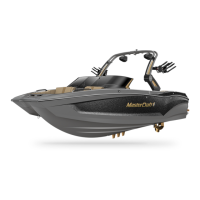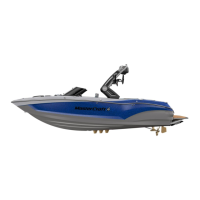• If the engine fails, tie a sea anchor on a line from the boat to keep the boat headed
into the waves. A bucket will work as a sea anchor in an emergency.
• Anchor the boat, if necessary.
• Seek shelter on-shore whenever possible. Particularly avoid riding out a storm that
includes high wind and/or lightning, which is especially dangerous. Avoid contact
with metal portions of the boat such as handrails, windshields, tower and cleats.
Staying Afloat
It is commonly believed that someone dressed in heavy clothing or waders will ex-
perience considerably more diculty staying aoat if they fall overboard. This is not true.
Air trapped in clothing provides otation and bending the knees will trap air in waders. To
stay aoat:
• Remain calm. Do not thrash about or try to remove clothing or footwear. This leads
to exhaustion and increases the loss of air that may keep you aoat.
• Keep your PFD on.
• Keep your knees bent.
• Float on your back and paddle slowly to safety.
Cold Water Survival
Sudden immersion in cold water can induce rapid, uncontrolled breathing, cardiac
arrest and other physical body conditions, which can lead to drowning. Always wearing a
PFD will help survival in rapid immersion situations.
In other situations when entry into cold water is necessary:
• Wear a PFD.
• Button all clothing.
• Cover your head if possible and enter the water slowly.
• Keep your head out of the water if at all possible.
• Assume the Heat Escape Lessening Posture (HELP) position as taught within a
Coast Guard-taught safety course. Information about HELP is available online.
Hypothermia
Immersion in water speeds the loss of body heat and can lead to hypothermia. This
is the abnormal lowering of internal body temperature. If a boat capsizes it will likely oat
on or just below the surface.
To reduce the eects of hypothermia, get in or on the boat. Try to get as much of
your body out of the water as possible. If you can’t get in the boat, a PFD will enable you
to keep your head out of the water. This is very important because about 50 percent of
body heat loss is from the head.
It may be possible to revive a drowning victim who has been under water for some
time and shows no sign of life. Cases document instances where victims have been
resuscitated after extended periods. Start CPR immediately and get the victim to a hos-
pital as quickly as possible.
Immersion Suits
Immersion suits will delay the eects of hypothermia in cold water and are avail-
able through many retailers who specialize in sales of marine products. The suits should
be stored and maintained according to the manufacturer’s instructions.
Inflatable Life Rafts
An inatable life raft can provide a survival platform for an extended period of time.
Be sure the life raft is large enough for everyone on board when the boat operates o-
shore. It should have the appropriate emergency equipment pack and should be profes-
sionally serviced periodically, according to the manufacturer’s instructions. Coast Guard-
approved life rafts must meet a number of stringent material and performance standards.
2013 MasterCraft Owners Manual • Safety Knowledge • Page 1-17

